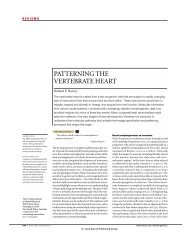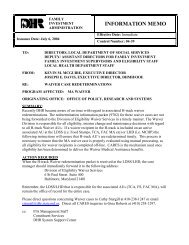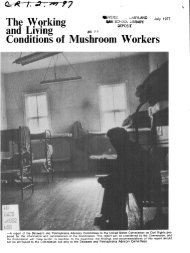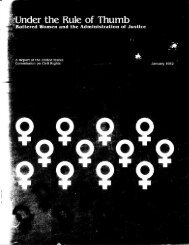unsuccessful efforts <strong>of</strong> a private attorney—promptedby a whistle blower—to obtain a court order forsurgery; and the unsuccessful efforts <strong>of</strong> the Department<strong>of</strong> Health and Human Services to gain accessto her medical records. 54 Finally, throughout thecontroversy, the accounts <strong>of</strong> the future predicted forher—should she survive—were unremittingly bleak.The director <strong>of</strong> the American Academy <strong>of</strong> Pediatrics,Dr. Harry Jennison, said, "'Baby JaneDoe'. . .not only has spina bifida but fluid on thebrain and an abnormally small brain. The baby is soseverely deformed that there is nothing that can bedone." 55 A Los Angeles Times editorial noted,"Doctors say that without surgery the girl may liveup to two years; with it she could live until she is 20,but she would be severely retarded, epileptic andparalyzed from the waist down, as well as inconstant pain." 56The Washington Post quoted the court testimony<strong>of</strong> pediatric neurologist Dr. George Newman: "[O]nthe basis <strong>of</strong> the combination <strong>of</strong> malformations thatare present in this child, she is not likely to everachieve any meaningful interaction with her environment,nor ever achieve any interpersonal relationships.. . ."" Newman also testified, "It's unlikelythat she is going to develop any cognitiveskills" and would experience "nothing whatsoever"that he considered positive on the cognitive scale. 58The baby's parents described in an interview whatthey were told about the child's future by medicalpersonnel—the information on the basis <strong>of</strong> whichthey decided against surgery:"We were told. . .that the part <strong>of</strong> the brain that controlsmuch <strong>of</strong> our awareness was either missing or not entirelyformed.We are not talking about a spina bifida child,. . .onewho could perhaps walk someday with braces. . . .Shewill be an epileptic. Her condition for future life is to bebedridden, and she would not have use <strong>of</strong> her hands.54See chap. 5, text accompanying notes 25-32; and chap. 6, textaccompanying notes 89-107.55Pro and Con[] Should Uncle Sam Protect Handicapped Babies?U.S. News & World Report, Jan. 16, 1984, at 63, 64.56 Indecent Zealotry, Los Angeles Times, Nov. 16, 1983, pt. II, at6.57Barringer, Meese Approved Intervention in Baby Case, WashingtonPost, Nov. 16, 1983, at A16.»» Transcript at 47, 95-96, People ex rel Washburn v. StonyBrook Hosp., No. 83-19910 (N.Y. Sup. Ct. Oct. 19, 1983).59Quoted in J. Lyon, Playing God in the Nursery 51-52 (1985).80Caplan, Is It a Life? The Nation, Jan. 21, 1984, at 37, 37.We also know that as she grew older, she would alwaysbe an infant. She would never know love. And while shemight feel sorrow and joy, her overall condition would bepain." 59Asking "Is it a Life?" bioethicist Arthur Caplan(then on the staff <strong>of</strong> the prestigious Hastings Center)wrote <strong>of</strong> Baby Jane Doe, "No one should be forcedby the government, [or] civil libertarians. . .to livesuch a life, even briefly." 60Notwithstanding the legal efforts opposed toproviding medical treatment for Baby Jane Doe, sheis alive today. 61 Although the courts had upheld herparents' decision to withhold operations to install ashunt and to close her back, the parents had time tochange their minds. A shunt was installed, her backhealed, and she was taken home. 62 As she left thehospital, Dr. George Newman had not changed hisprognosis: "She will still be severely retarded and, Istill think, bedridden all the days <strong>of</strong> her life." 63When they took her home, her father commentedto a reporter, "We're happy because she appears tobe happy." 64 About a month later, a reporterdescribed her as "smiling and cooing as her motherfeeds her. . . .[S]he grasps a visitor's finger in a tinyfist. . . ," 65 Already she was using her "unusable"hands. In June 1986, when she was 2 years and 8months old:Her. . .father said [she] likes to throw a ball to thefamily's golden retriever, cruise around in a walker and tryto sing "Row, Row, Row Your Boat." He said he and hiswife decided initially against surgery because it appearedshe could die at any moment and they did not want to addto the baby's pain."All <strong>of</strong> a sudden it turned around," he said. "From thatmoment on, we really saw her sense <strong>of</strong> fighting and senseto live and we were full steam ahead with what had to bedone for her." 68In December 1987, when she was 4, a reporterwrote <strong>of</strong> her, "Keri-Lynn talks and laughs; she61Baer, The Half-told Story <strong>of</strong> Baby Jane Doe, Col. JournalismRev., Nov.-Dec. 1984, at 35, 38.62Horan & Balch, Infant Doe and Baby Jane Doe: MedicalTreatment <strong>of</strong> the Handicapped Newborn, 52 Linacre Q. 45, 54(1985). Healing <strong>of</strong> the spinal lesion is rare without surgery but notwithout precedent.83Quoted in Lyon, supra note 59 at 55.84 Baby Jane Doe Goes Home, Milwaukee J., Apr. 6,1984, pt. 2, at3, col. 1.•* 'Adorable' Baby Jane Doe Finally Is Home, MilwaukeeSentinel, May 25, 1984, pt. 1, at 8, col. 1.66Associated Press, "Baby Doe" Parents Applaud Supreme CourtRuling, Domestic News PM Cycle, June 10, 1986.40
smiles and hugs and screams and plants kisses firmlyon a stranger's cheek." 67 She was using a wheelchairand attending school. 68 "I'm thrilled as canbe," her father said. "The fact that she's able torelate to us and her environment is amazing. Hermental awareness is fabulous now." 69 She was"learning to mix with her peers." 70 Of course, shestill has spina bifida. She does not walk, and requiresfrequent catheterization; she has had to have surgeryfor a dislocated hip. 71 But, in the followingdescription <strong>of</strong> Baby Jane Doe at 4, it is hard torecognize the pain-wracked, unaware, bedriddencreature <strong>of</strong> her doctors' confident predictions:She has recently begun to demand more than her shareand <strong>of</strong>ten resorts to throwing toys or M&Ms when thefocus shifts away from her. Then she whispers, "I'm bad,"aware that her mother is displeased with her behavior.. . .Later, she whispered, "Dance, Daddy, dance," asher father swept her into his arms to sway to the music <strong>of</strong>Stevie Wonder. 72A woman who works in parent support inPhoenix, Arizona, told the Commission about asimilar story:We also have our own little Baby Doe in Arizona andher name is Jessie. . Jessie was supposed to die the firstnight that she was born. She also had spina bifida,hydrocephalus, lots <strong>of</strong> severe brain damage, and all <strong>of</strong>those things that were not compatible with life, so notreatment was done for Baby Jessie. Days and days anddays went on and Baby Jessie fooled everybody and didnot die.Finally about the 21st day, right at the time the signswere hanging up in the nurseries, somebody got realnervous and said, maybe she's not going to die, maybe webetter do surgery. So by this time, unfortunately it wasreally too late to do much repair on her back, but they didput a shunt in and that little girl now talks in sentences andgoes to regular preschool.Her family really believed what the doctors said: Shewill die. So they just waited for her to die. And so for me87Kerr, Baby Doe's Success[S\ Progress Defying Prognosis, Newsday,Dec. 7, 1987, at 2.68Kerr, Baby Doe's Success\:] Legal, Medical Legacy <strong>of</strong> Case,Newsday, Dec. 7, 1987, at 2, 23.69Kerr, Baby Doe's Success[S\ Progress Defying Prognosis, Newsday,Dec. 7, 1987, at 2, 23.70Kerr, Baby Doe's Success[f] Legal, Medical Legacy <strong>of</strong> Case,Newsday, Dec. 7, 1987, at 2, 23.71Kerr, Baby Doe's Success[S\ Progress Defying Prognosis, Newsday,Dec. 7, 1987, at 2, 23.72Id.73Protection <strong>of</strong> Handicapped Newborns: Hearing Before the UnitedStates Commission on Civil Rights 264-65 (1986) (vol. II) (testimony<strong>of</strong> Betsy Trombino).as a parent I have a real difficult time with someonemaking that kind <strong>of</strong> a prognosis for a child and not doingany treatment. Because I have seen too many kids whodefy all the prognoses made for them. 73One family in the Chicago area can give twoexamples <strong>of</strong> negative predictions disproved. Theyare the adoptive parents <strong>of</strong> a child with spina bifidaleft to die in Robinson, Illinois, until the JusticeDepartment intervened. 74 When he was a year old,the Chicago Tribune reported that his adoptiveparents "believe that his alertness proves there hasbeen no brain damage and that his paralysis from theknees down won't keep him from walking." 75 Theirother example is their child born a few years earlier:"When she was 4 months old, the doctor told us she hadsome kind <strong>of</strong> neurological impairment—they still don'tknow exactly what. They advised us to put her in aninstitution and forget about her," said the mother.The child is now an alert, active 5-year-old who movesnormally around the house, and speaks many words, withonly slight hesitation. 76Patricia McGill Smith, deputy director <strong>of</strong> theNational Information Center for Handicapped Childrenand Youth, told the Commission about a case inOmaha, Nebraska. A child was born with spinabifida, and there was "a recommendation <strong>of</strong> notreatment based on the fact that the child had spinabifida and predictable mental retardation." After 4months <strong>of</strong> debate, the parents changed their initialdecision to accept that recommendation, and thechild received treatment and lived. Ms. Smithtestified, "I have tracked the progress <strong>of</strong> that childand that family ever since. The young lady had nomental retardation whatsoever." 77Such positive results for children born with spinabifida are not anomalous. Dr. David McLone, whoheads a major neurosurgical department and formerlychaired the Pr<strong>of</strong>essional Advisory Council <strong>of</strong> theSpina Bifida Association <strong>of</strong> America, testified:74Telephone interview with Robert D'Agostino, Former DeputyAssistant Attorney General, Civil Rights Division, Department<strong>of</strong> Justice (Dec. 1, 1988).75Nelson, 2d miracle baby gives family joy, Chicago Tribune, Apr.24. 1983, Sec. 3, at 1, col. 1.76Id.77Protection <strong>of</strong> Handicapped Newborns: Hearing Before the UnitedStates Commission on Civil Rights 254-55 (1986) (vol. II) (testimony<strong>of</strong> Patricia McGill Smith, Deputy Director, National InformationCenter for Handicapped Children and Youth).41
- Page 1 and 2: MedicalDiscriminationAgainstChildre
- Page 3 and 4: idments • Section 504 • Medical
- Page 5: LETTER OF TRANSMITTALThe PresidentT
- Page 9 and 10: CONTENTSExecutive Summary 11. Funda
- Page 11: 12. The Performance of the Federal
- Page 14 and 15: • The role of economic considerat
- Page 16 and 17: disabilities at the time that the c
- Page 19 and 20: generated by health care personnel
- Page 21: ing how they would obtain medical r
- Page 24 and 25: The Commission sees several advanta
- Page 26 and 27: acquiescence in the death or elimin
- Page 28 and 29: Services of the Department of Healt
- Page 30 and 31: Chapter 1Fundamental Rights: An Int
- Page 32 and 33: Carlton Johnson was evaluated by a
- Page 34 and 35: "that Mr. and Mrs. Doe, after havin
- Page 36 and 37: American Coalition of Citizens with
- Page 38 and 39: Chapter 2The Physician-Parent Relat
- Page 40 and 41: In all but a few cases, the parents
- Page 42 and 43: the family, and the family went alo
- Page 44 and 45: Chapter 3The Role of Quality of Lif
- Page 47: transition from education to employ
- Page 50 and 51: tion programs can become productive
- Page 54 and 55: [S]ince I have been at Children's M
- Page 56 and 57: Another survey by Siperstein, Wolra
- Page 58 and 59: of life with a child who is disable
- Page 60 and 61: Chapter 4The Role of Economic Consi
- Page 62 and 63: ©TABLE 4.1Pediatricians' Responses
- Page 64 and 65: • The differences in average cost
- Page 66 and 67: FIGURE 4.1Comparative Costs of Inst
- Page 68 and 69: Chapter 5State LawWhat is the law g
- Page 70 and 71: Like all authority. . .parental aut
- Page 72 and 73: This decision, however, was promptl
- Page 74 and 75: No otherwise qualified handicapped
- Page 76 and 77: Bloomington's Infant Doe in April 1
- Page 78 and 79: ONONTABLE 6.1Physician's assessment
- Page 80 and 81: Essentially, HHS interpreted the su
- Page 82 and 83: Final 504 RuleHHS received nearly 1
- Page 84 and 85: lifesaving operations to close her
- Page 86 and 87: any further implementation of the F
- Page 88 and 89: handicapped infants might violate S
- Page 90 and 91: the provision does cover discrimina
- Page 92 and 93: of the infants. The review mechanis
- Page 94 and 95: Under the law, the Department of He
- Page 96 and 97: that "the phrase 'or holds the reas
- Page 98 and 99: allows an infant to be denied nutri
- Page 100 and 101: avoid the explicit standards set fo
- Page 102 and 103:
(as opposed to the far) future, the
- Page 104 and 105:
It was recognized, therefore, that
- Page 106 and 107:
als with the particular disability
- Page 108 and 109:
cared for. They are thus different,
- Page 110 and 111:
medical advice. Given the magnitude
- Page 112 and 113:
tions at all regarding the subject
- Page 114 and 115:
strates that there is a grave dange
- Page 116 and 117:
Disincentives to Whistle BlowingDen
- Page 118 and 119:
Using a cumulative scaling procedur
- Page 120 and 121:
Of that 300 we targeted, approximat
- Page 122 and 123:
Conclusionphysicians set forth in t
- Page 124 and 125:
taking place when a report of suspe
- Page 126 and 127:
where the parents say "the child fe
- Page 128 and 129:
Nevertheless, the organization oppo
- Page 130 and 131:
Chapter 11The Role and Performance
- Page 132 and 133:
a member of the American Academy of
- Page 134 and 135:
possibilities that "will be most li
- Page 136 and 137:
clearly indicate that the committee
- Page 138 and 139:
Reviewing the first 30 months of th
- Page 140 and 141:
Webster's defines "suspected" as "t
- Page 142 and 143:
Chapter 12The Performance of the Fe
- Page 144 and 145:
The baby's doctor, E. Laurence Hode
- Page 146 and 147:
to achieve a reasonable life". . .w
- Page 148 and 149:
an unmarried mother receiving welfa
- Page 150 and 151:
can be sure all appropriate actions
- Page 152 and 153:
inquiries to determine whether they
- Page 154 and 155:
Chapter 13The Protection and Advoca
- Page 156 and 157:
authority to conduct retrospective
- Page 158 and 159:
facility that uses such a committee
- Page 160 and 161:
Chapter 14Findings and Recommendati
- Page 162 and 163:
as the coordination and development
- Page 164 and 165:
in the advisory process who is conc
- Page 166 and 167:
A Dissenting View on the Report Med
- Page 168 and 169:
arts) to depend upon knowledge of h
- Page 170 and 171:
Attachments to Statement of William
- Page 172 and 173:
medical facility. Considerations su
- Page 174 and 175:
Fund for the Improvement of Postsec
- Page 176 and 177:
eports such as Kopelman et al. demo
- Page 178 and 179:
Appendix 1EXPOSING OUR CHILDREN, EX
- Page 180 and 181:
abilities or functions, they are de
- Page 182 and 183:
My principal reason for objecting t
- Page 184 and 185:
I derive this hint from the many co
- Page 186 and 187:
moral distinction. A girl is a huma
- Page 188 and 189:
Appendix 2SURVEY OFSTATE BABY DOE P
- Page 190 and 191:
insure the immediate referral of po
- Page 192 and 193:
Hospital Liaisons Designated in Mos
- Page 194 and 195:
BABY DOE COMPARED WITH REGULAR CPS
- Page 196 and 197:
We also asked state CPS offices wha
- Page 198 and 199:
Limited information was available o
- Page 200 and 201:
one-quarter felt that baby doe case
- Page 202 and 203:
Appendix 3INFANT CARE REVIEW COMMIT
- Page 204 and 205:
and guidelines concerning the withh
- Page 206 and 207:
treated to assure the prompt ^repor
- Page 208 and 209:
3. Educating Staff and FamiliesThre
- Page 210 and 211:
One of the 10 ethics committees vis
- Page 212 and 213:
asphyxiation during the birth proce
- Page 214 and 215:
Prospective Review -- Each committe
- Page 216 and 217:
OBSERVATIONSThe inspection found th
- Page 218 and 219:
May 1, 1989Page 2The Commission adv
- Page 220 and 221:
Doe 1 admitted on the record of the
- Page 222 and 223:
tion is the basis for failure to tr
- Page 224:
her (much appreciated) vote for thi
















